Multi-Objectives Optimization of Ventilation Controllers for Passive Cooling in Residential Buildings
Abstract
:1. Introduction
2. Research Problem Determination
3. Method
3.1. Fuzzy Logic Controller—Description and Basic Assumption
- minimal air change rate (ACH) is 0.3 h−1,
- ventilation may be increased if the outside temperature (Tout) is less than the inside room temperature (Tin),
- additional ventilation will start if the room is not heated and the temperature exceeds the heating set point,
- input data for the FLC can only be temperature (indoor and outdoor air).
- weighted average of the highest outdoor temperatures (Tmax_avg) in the last three days,
- outdoor temperature at current time step (Tout),
- and for the calculation of the additional instantaneous air change rate at each time step (ACH—local factor, calculated for each room separately) are:
- the temperature difference between indoor and outdoor temperature at the time step (dTin_out),
- the temperature difference between the indoor temperature and Tvent at the time step (dTin_vent).
3.2. Optimization of FLC
3.2.1. Encoding Method for Membership Function
3.2.2. Encoding Method, Learning and Reduction Technique for Logic Rules
- v.1:
- if —exclude the jth rule from the candidate rule base,
- v.2:
- if —include the jth rule directly to the rule base,
- v.3:
- if —combines the two or more consequences into one using the equation:where: is the number of consequence, is the center numeric values of fuzzy rule consequence. A linguistic variable with the highest membership value for NV is the result of different consequences.
3.2.3. Multi-Objective Optimization Process
3.3. Employed Tools
- the utopia point method (utopia criterion (UC)): the best FLC is the closest to the ideal point (point that minimizes both objective function). As stated in [57] this approach has already been used in many engineering applications;
- the maximum thermal comfort method (thermal comfort criterion (TCC)): Hdis for this FLC is minimal. Due to the character of this work, the method is used and compared with the utopia point method.
3.4. Research Building Description and Energy Simulation Assumption
3.5. Thermal Model Validation
4. Results
- a building with ventilation using ambient air maintained at a constant level 0.5 h−1 from 1st May to 30th September and on the level 0.3 h−1 in the rest of the year (case B1);
- a building with ventilation using ambient air maintained at a constant level 0.3 h−1 during the whole year and air conditioning system (case B2).
5. Conclusions
Acknowledgments
Author Contributions
Conflicts of Interest
References
- Moran, P.; Goggins, J.; Hajdukiewicz, M. Super-insulate or use renewable technology? Life cycle cost, energy and global warming potential analysis of nearly zero energy buildings (NZEB) in a temperate oceanic climate. Energy Build. 2017, 139, 590–607. [Google Scholar] [CrossRef]
- Liu, L.; Rohdin, P.; Moshfegh, B. LCC assessments and environmental impacts on the energy renovation of a multi-family building from the 1890s. Energy Build. 2016, 133, 823–833. [Google Scholar] [CrossRef]
- Khanmirza, E.; Esmaeilzadeh, A.; Markazi, A.H.D. Predictive control of a building hybrid heating system for energy cost reduction. Appl. Soft Comput. 2016, 46, 407–423. [Google Scholar] [CrossRef]
- Aflaki, A.; Mahyuddin, N.; Mahmoud, Z.A.-C.; Baharum, M.R. A review on natural ventilation applications through building façade components and ventilation openings in tropical climates. Energy Build. 2015, 101, 153–162. [Google Scholar] [CrossRef]
- Calautit, J.K.; Hughes, B.R. Wind tunnel and CFD study of the natural ventilation performance of a commercial multi-directional wind tower. Build. Environ. 2014, 80, 71–83. [Google Scholar] [CrossRef]
- Manzano-Agugliaro, F.; Montoya, F.G.; Sabio-Ortega, A.; García-Cruz, A. Review of bioclimatic architecture strategies for achieving thermal comfort. Renew. Sustain. Energy Rev. 2015, 49, 736–755. [Google Scholar] [CrossRef]
- Moosavi, L.; Mahyuddin, N.; Ab Ghafar, N.; Ismail, M.A. Thermal performance of atria: An overview of natural ventilation effective designs. Renew. Sustain. Energy Rev. 2014, 34, 654–670. [Google Scholar] [CrossRef]
- Yun, J.; Won, K.-H. Building environment analysis based on temperature and humidity for smart energy systems. Sensors 2012, 12, 13458–13470. [Google Scholar] [CrossRef] [PubMed]
- Artmann, N.; Manz, H.; Heiselberg, P. Climatic potential for passive cooling of buildings by night-time ventilation in Europe. Appl. Energy 2007, 84, 187–201. [Google Scholar] [CrossRef]
- Oropeza-Perez, I.; Østergaard, P.A. Active and passive cooling methods for dwellings: A review. Renew. Sustain. Energy Rev. 2018, 82, 531–544. [Google Scholar] [CrossRef]
- Alonso, M.J.; Mathisen, H.M.; Collins, R. Ventilative cooling as a solution for highly insulated buildings in cold climate. Energy Procedia 2015, 78, 3013–3018. [Google Scholar] [CrossRef] [Green Version]
- Inard, C.; Pfafferott, J.; Ghiaus, C. Free-running temperature and potential for free cooling by ventilation: A case study. Energy Build. 2011, 43, 2705–2711. [Google Scholar] [CrossRef]
- Campaniço, H.; Hollmuller, P.; Soares, P.M.M. Assessing energy savings in cooling demand of buildings using passive cooling systems based on ventilation. Appl. Energy 2014, 134, 426–438. [Google Scholar] [CrossRef]
- Yao, R.; Li, B.; Steemers, K.; Short, A. Assessing the natural ventilation cooling potential of office buildings in different climate zones in China. Renew. Energy 2009, 34, 2697–2705. [Google Scholar] [CrossRef]
- Santamouris, M.; Sfakianaki, A.; Pavlou, K. On the efficiency of night ventilation techniques applied to residential buildings. Energy Build. 2010, 42, 1309–1313. [Google Scholar] [CrossRef]
- Tejero-González, A.; Andrés-Chicote, M.; García-Ibáñez, P.; Velasco-Gómez, E.; Rey-Martínez, F.J. Assessing the applicability of passive cooling and heating techniques through climate factors: An overview. Renew. Sustain. Energy Rev. 2016, 65, 727–742. [Google Scholar] [CrossRef]
- Rinaldi, A.; Roccotelli, M.; Mangini, A.M.; Fanti, M.P.; Iannone, F. Natural ventilation for passive cooling by means of optimized control logics. Procedia Eng. 2017, 180, 841–850. [Google Scholar] [CrossRef]
- Del Mar Castilla, M.; Alvarez, J.D.; Normey-Rico, J.E.; Rodrıguez, F.; Berenguel, M. A multivariable nonlinear MPC control strategy for thermal comfort and indoor-air quality. In Proceedings of the 39th Annual Conference of the IEEE Industrial Electronics Society (IECON 2013), Vienna, Austria, 10–13 November 2013; pp. 7908–7913. [Google Scholar]
- Wang, Z.; Wang, L. Intelligent Control of Ventilation System for Energy-Efficient Buildings with CO2 Predictive Model. IEEE Trans. Smart Grid 2013, 4, 686–693. [Google Scholar] [CrossRef]
- Homod, R.Z.; Sahari, K.S.M. Energy savings by smart utilization of mechanical and natural ventilation for hybrid residential building model in passive climate. Energy Build. 2013, 60, 310–329. [Google Scholar] [CrossRef]
- Kolokotroni, M.; Perera, M.D.A.E.S.; Azzi, D.; Virk, G.S. An investigation of passive ventilation cooling and control strategies for an educational building. Appl. Therm. Eng. 2001, 21, 183–199. [Google Scholar] [CrossRef]
- Ghiaus, C.; Allard, F. Potential for free-cooling by ventilation. Sol. Energy 2006, 80, 402–413. [Google Scholar] [CrossRef]
- Ferdyn-Grygierek, J.; Grygierek, K. Optimization of window size design for detached house using TRNSYS simulations and genetic algorithm. Archit. Civ. Eng. Environ. 2017, 10, 133–140. [Google Scholar]
- Ferdyn-Grygierek, J.; Grygierek, K. Multi-variable optimization of building thermal design using genetic algorithms. Energies 2017, 10, 1570. [Google Scholar] [CrossRef]
- Gacto, M.J.; Alcala, R.; Herrera, F. A multi-objective evolutionary algorithm for an effective tuning of fuzzy logic controllers in heating, ventilating and air conditioning systems. Appl. Intell. 2012, 36, 330–347. [Google Scholar] [CrossRef]
- Ahmad, M.W.; Mourshed, M.; Yuce, B.; Rezgui, Y. Computational intelligence techniques for HVAC systems: A review. Build. Simul. 2016, 9, 359–398. [Google Scholar] [CrossRef]
- So, A.T.P.; Chan, W.; Tse, W. Self-learning fuzzy air handling system controller. Build. Serv. Eng. Res. Technol. 1997, 18, 99–108. [Google Scholar] [CrossRef]
- Holland, J. Adaptation in Natural and Artificial Systems; MIT Press: Cambridge, MA, USA, 1992. [Google Scholar]
- Grygierek, K. Optimization of trusses with self-adaptive approach in genetic algorithms. Archit. Civ. Eng. Environ. 2016, 9, 67–78. [Google Scholar]
- Shill, P.C.; Akhand, M.A.H.; Asaduzzaman, M.D.; Murase, K. Optimization of fuzzy logic controllers with rule base size reduction using genetic algorithms. Int. J. Inf. Technol. Decis. Mak. 2015, 14, 1063–1092. [Google Scholar] [CrossRef]
- Kennedy, J.; Eberhart, R. Particle swarm optimization. In Proceedings of the IEEE International Conference on Neural Networks, The University of Western Australia, Perth, Australia, 27 November–1 December 1995; pp. 1942–1948. [Google Scholar]
- Zhang, Y.; Wu, L. Crop Classification by forward neural network with adaptive chaotic particle swarm optimization. Sensors 2011, 11, 4721–4743. [Google Scholar] [CrossRef] [PubMed]
- Wang, S.; Phillips, P.; Yang, J.; Sun, P.; Zhang, Y. Magnetic resonance brain classification by a novel binary particle swarm optimization with mutation and time-varying acceleration coefficients. Biomed. Eng. Biomed. Tech. 2016, 61, 431–441. [Google Scholar] [CrossRef] [PubMed]
- Zhang, Y.; Wang, S.; Ji, G. A Comprehensive Survey on Particle Swarm Optimization Algorithm and Its Application. Math. Probl. Eng. 2015, 2015, 931256. [Google Scholar] [CrossRef]
- Nabi, A.; Singh, A. Particle swarm optimization of fuzzy logic controller for voltage sag improvement. In Proceedings of the 3rd International Conference on Advanced Computing and Communication Systems (ICACCS-2016), Coimbatore, India, 22–23 January 2016. [Google Scholar]
- Mahmoodabadi, M.J.; Jahanshahi, H. Multi-objective optimized fuzzy-PID controllers for fourth order nonlinear systems. Eng. Sci. Technol. Int. J. 2016, 19, 1084–1098. [Google Scholar] [CrossRef]
- Kusiak, A.; Xu, G.; Tang, F. Optimization of an HVAC system with a strength multi-objective particle-swarm algorithm. Energy 2011, 36, 5935–5943. [Google Scholar] [CrossRef]
- Ghadimi, N. A new hybrid algorithm based on optimal fuzzy controller in multimachine power system. Wiley Period. 2014, 21, 78–93. [Google Scholar] [CrossRef]
- Chiou, Y.-C.; Lan, L.W. Genetic fuzzy logic controller: An iterative evolution algorithm with new encoding method. Fuzzy Sets Syst. 2005, 152, 617–635. [Google Scholar] [CrossRef]
- Polish Committee for Standardization. Polish Standard PN-EN ISO 7730:2006 Ergonomics of the Thermal Environment—Analytical Determination and Interpretation of Thermal Comfort Using Calculation of the PMV and PPD Indices and Local Thermal Comfort Criteria; Polish Committee for Standardization: Warsaw, Poland, 2006. (In Polish) [Google Scholar]
- Polish Committee for Standardization. Polish Standard PN-EN 15251:2012 Indoor Environmental Input Parameters for Design and Assessment of Energy Performance of Buildings Addressing Indoor Air Quality, Thermal Environment, Lighting and Acoustics; Polish Committee for Standardization: Warsaw, Poland, 2012. (In Polish) [Google Scholar]
- American Society of Heating, Refrigerating and Air Conditioning Engineers. ANSI/ASHRAE Standard 55-2017, Thermal Environmental Conditions for Human Occupancy; American Society of Heating, Refrigerating and Air Conditioning Engineers: Atlanta, GA, USA, 2017. [Google Scholar]
- Fanger, P.O. Thermal Comfort; Danish Technical Press: Copenhagen, Denmark, 1970. [Google Scholar]
- Magnier, L.; Haghighat, F. Multiobjective optimization of building design using TRNSYS simulations, genetic algorithm, and Artificial Neural Network. Build. Environ. 2010, 45, 739–746. [Google Scholar] [CrossRef]
- Deb, K.; Pratap, A.; Agarwal, S.; Meyarivan, T. A fast and elitist multiobjective genetic algorithm: NSGA-II. IEEE Trans. Evol. Comput. 2002, 6, 182–197. [Google Scholar] [CrossRef]
- Zitzler, E.; Laumanns, M.; Thiele, L. SPEA2: Improving the Strength Pareto Evolutionary Algorithm; TIK-Report 103; Swiss Federal Institute of Technology: Zurich, Switzerland, 2001. [Google Scholar]
- Zhao, H.; Magoulès, F. A review on the prediction of building energy consumption. Renew. Sustain. Energy Rev. 2012, 16, 3586–3592. [Google Scholar] [CrossRef]
- Ahmad, M.W.; Hippolyte, J.-L.; Reynolds, J.; Mourshed, M.; Rezgui, Y. Optimal scheduling strategy for enhancing IAQ, visual and thermal comfort using a genetic algorithm. In Proceedings of the IAQ 2016: Defining Indoor Air Quality: Policy, Standards and Best Paractices, Alexandria, VA, USA, 12–14 September 2016; pp. 183–191. [Google Scholar]
- Ferdyn-Grygierek, J.; Baranowski, A. Internal environment in the museum building Assessment and improvement of air exchange and its impact on energy demand for heating. Energy Build. 2015, 92, 45–54. [Google Scholar] [CrossRef]
- Baranowski, A.; Ferdyn-Grygierek, J. Heat demand and air exchange in a multifamily building—Simulation with elements of validation. Build. Serv. Eng. Res. Technol. 2009, 30, 227–240. [Google Scholar] [CrossRef]
- Ahmad, M.W.; Mourshed, M.; Rezgui, Y. Trees vs neurons: Comparison between random forest and ANN for high-resolution prediction of building energy consumption. Energy Build. 2017, 147, 77–89. [Google Scholar] [CrossRef]
- Li, C.; Ding, Z.; Zhao, D.; Yi, J.; Zhang, G. Building energy consumption prediction: An extreme deep learning approach. Energies 2017, 10, 1525. [Google Scholar] [CrossRef]
- Godina, R.; Rodrigues, E.M.G.; Pouresmaeil, E.; Matias, J.C.O.; Catalão, J.P.S. Model predictive control home energy management and optimization strategy with demand response. Appl. Sci. 2018, 8, 408. [Google Scholar] [CrossRef]
- Engineering Reference; EnergyPlus™ Version 8.7 Documentation; US Department of Energy: Washington, DC, USA, 2016; Available online: https://energyplus.net/sites/all/modules/custom/nrel_custom/pdfs/pdfs_v8.7.0/EngineeringReference.pdf (accessed on 12 February 2018).
- Trcka, M.; Hensen, J.L.M.; Wetter, M. Co-simulation for performance prediction of integrated building and HVAC systems—An analysis of solution characteristics using a two-body system. Simul. Pract. Theory 2010, 18, 957–970. [Google Scholar] [CrossRef]
- Bernal, W.; Behl, M.; Nghiem, T.X.; Mangharam, R. MLE+: A tool for integrated design and deployment of energy efcient building controls. In Proceedings of the 4th ACM Workshop on Embedded Sensing Systems for Energy-Efciency in Buildings, Toronto, ON, Canada, 6 November 2012; pp. 123–130. [Google Scholar]
- Nguyen, A.T.; Reiter, S.; Rigo, P. A review on simulation-based optimization methods applied to building performance analysis. Appl. Energy 2014, 113, 1043–1058. [Google Scholar] [CrossRef]
- Polish Ministry of Infrastructure. Regulation of the Minister of Infrastructure of 12 April 2002 on the Technical Conditions That Should Be Met by Buildings and Their Location; Journal of Laws of the Republic of Poland No 75, Item. 690, (with Recast); Polish Ministry of Infrastructure: Warsaw, Poland, 2002. (In Polish)
- EnergyPlus Weather file. Available online: https://energyplus.net/weather-location/europewmoregion6/POL//POLKatowice.125600IMGW (accessed on 12 February 2017).
- American Society of Heating, Refrigerating and Air Conditioning Engineers. ASHRAE Handbook: Fundamentals, SI ed.; American Society of Heating, Refrigerating and Air Conditioning Engineers: Atlanta, GA, USA, 1997. [Google Scholar]
- Recknagel, H.; Schramek, E.R. Handbook. Heating, Air Conditioning, Domestic Hot Water, Refrigerator Technology; Omni Scala: Wrocław, Poland, 2008. (In Polish) [Google Scholar]
- Polish Committee for Standardization. Polish Standard PN-83/B-03430/Az3:2000 Ventilation in Dwellings and Public Utility Buildings; Polish Committee for Standardization: Warsaw, Poland, 2000. (In Polish) [Google Scholar]
- Kaczmarczyk, J.; Baranowski, A.; Ferdyn-Grygierek, J. Impact of building structure and operation on the operative temperature determination based on air and mean radiant temperatures. In Proceedings of the 10th International Conference on Healthy Buildings, Brisbane, Australia, 8–12 July 2012; The International Society of Indoor Air Quality and Climate, Queensland University of Technology: Brisbane, Australia, 2012. [Google Scholar]
- University of Strathclyde Energy Systems Research Unit. The ESP-r System for Building Energy Simulation; User Guide Version 10 Series; ESRU Manual U02/1; University of Strathclyde Energy Systems Research Unit: Glasgow, UK, 2002. [Google Scholar]
- Equa Simulation AB. Technical Report: Validation of IDA Indoor Climate and Energy 4.0 Build 4 with Respect to ANSI/ASHRAE Standard 140-2004; Equa Simulation: Solna, Sweden, 2010. [Google Scholar]

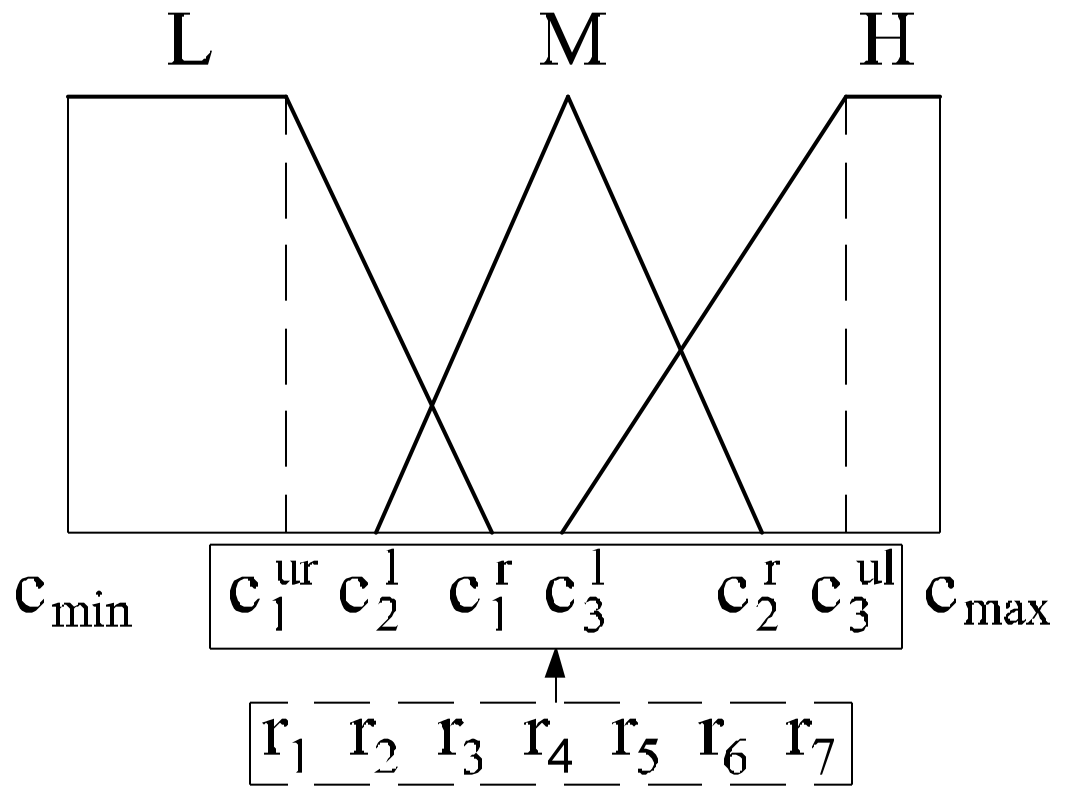

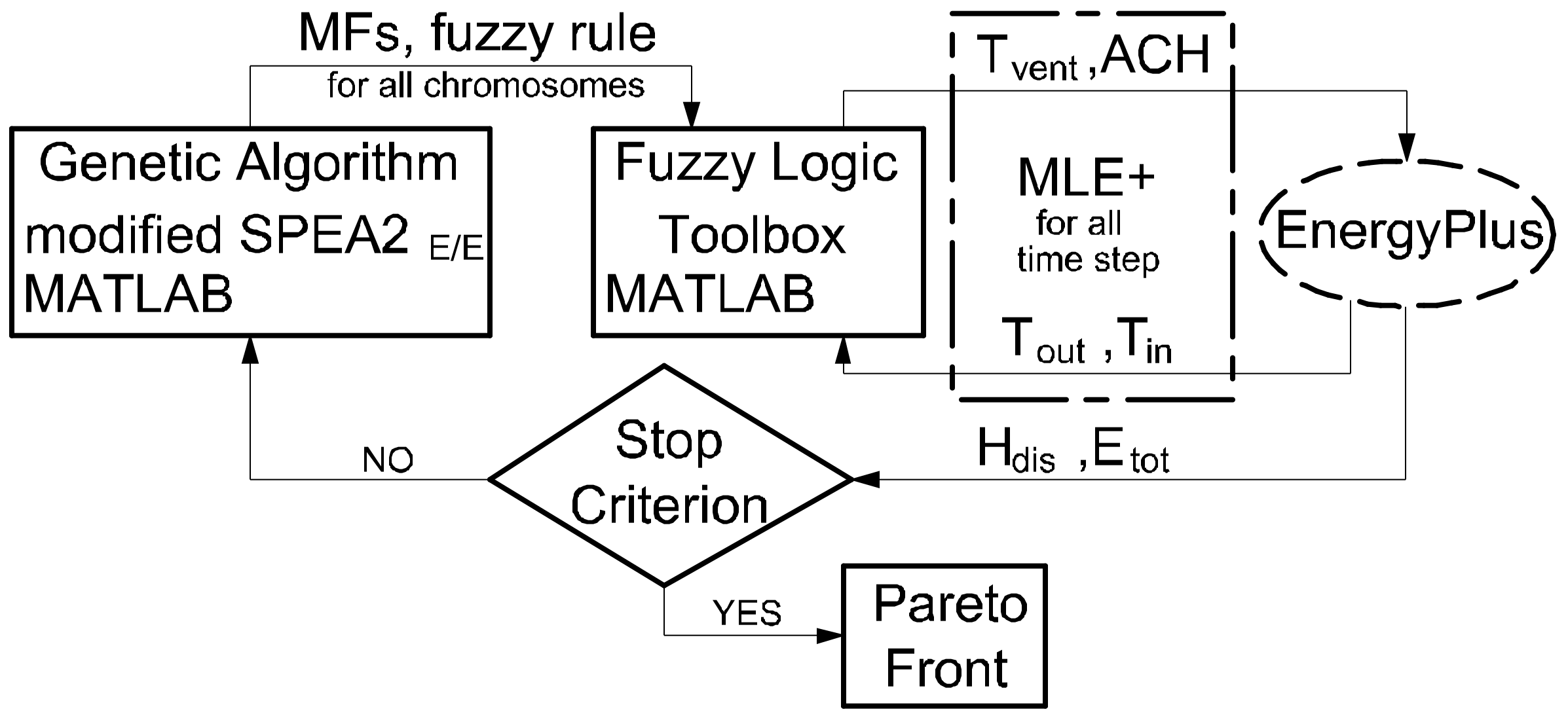



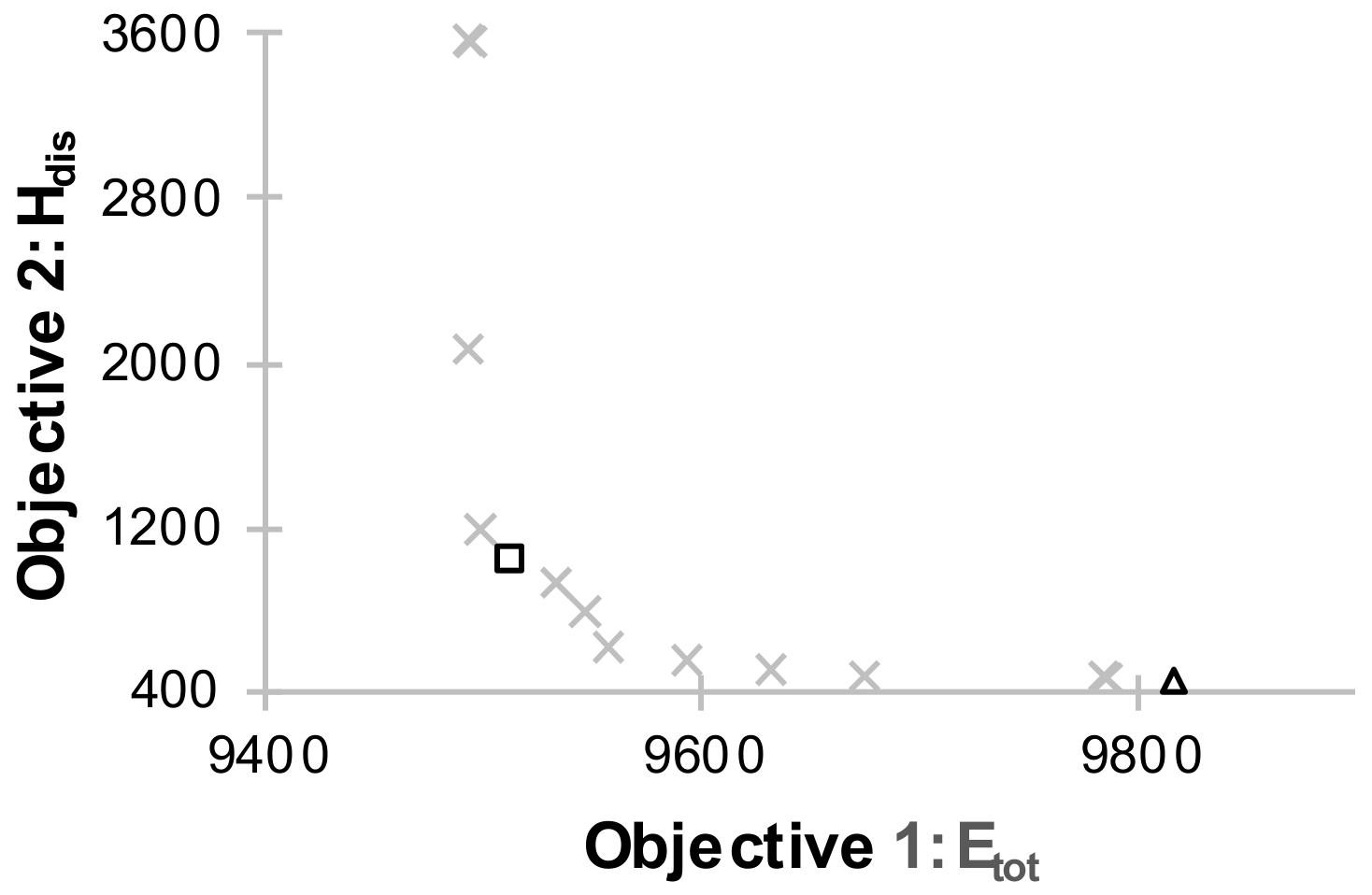


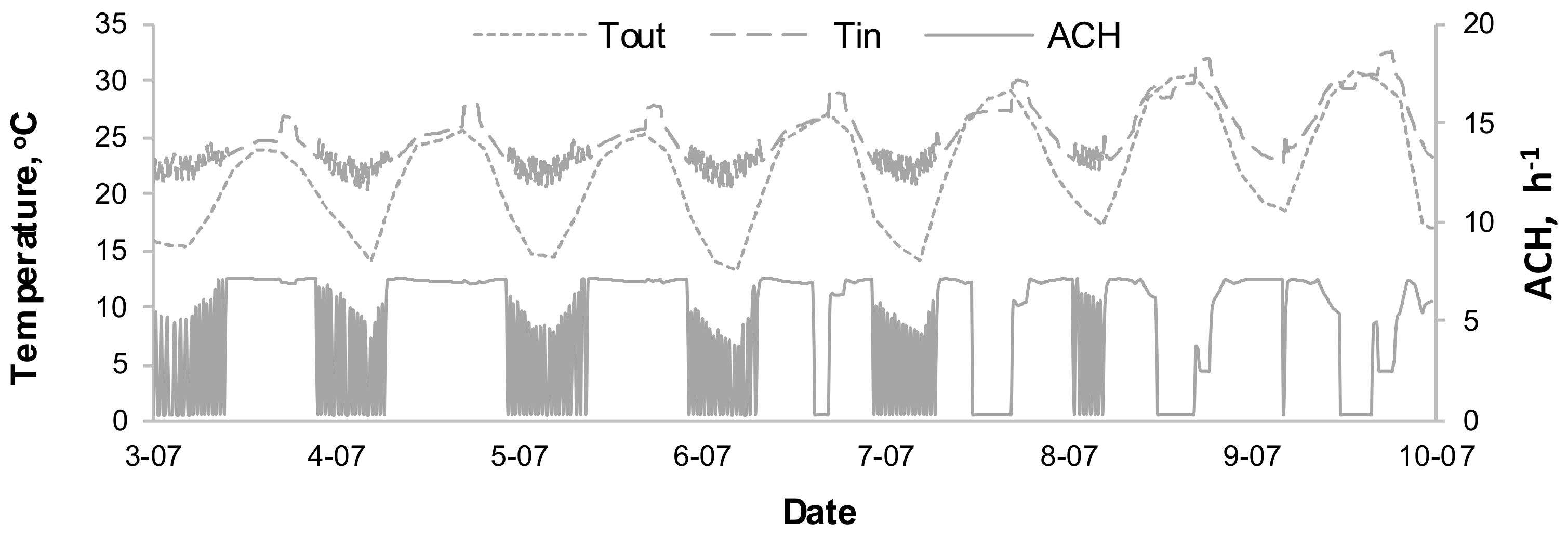


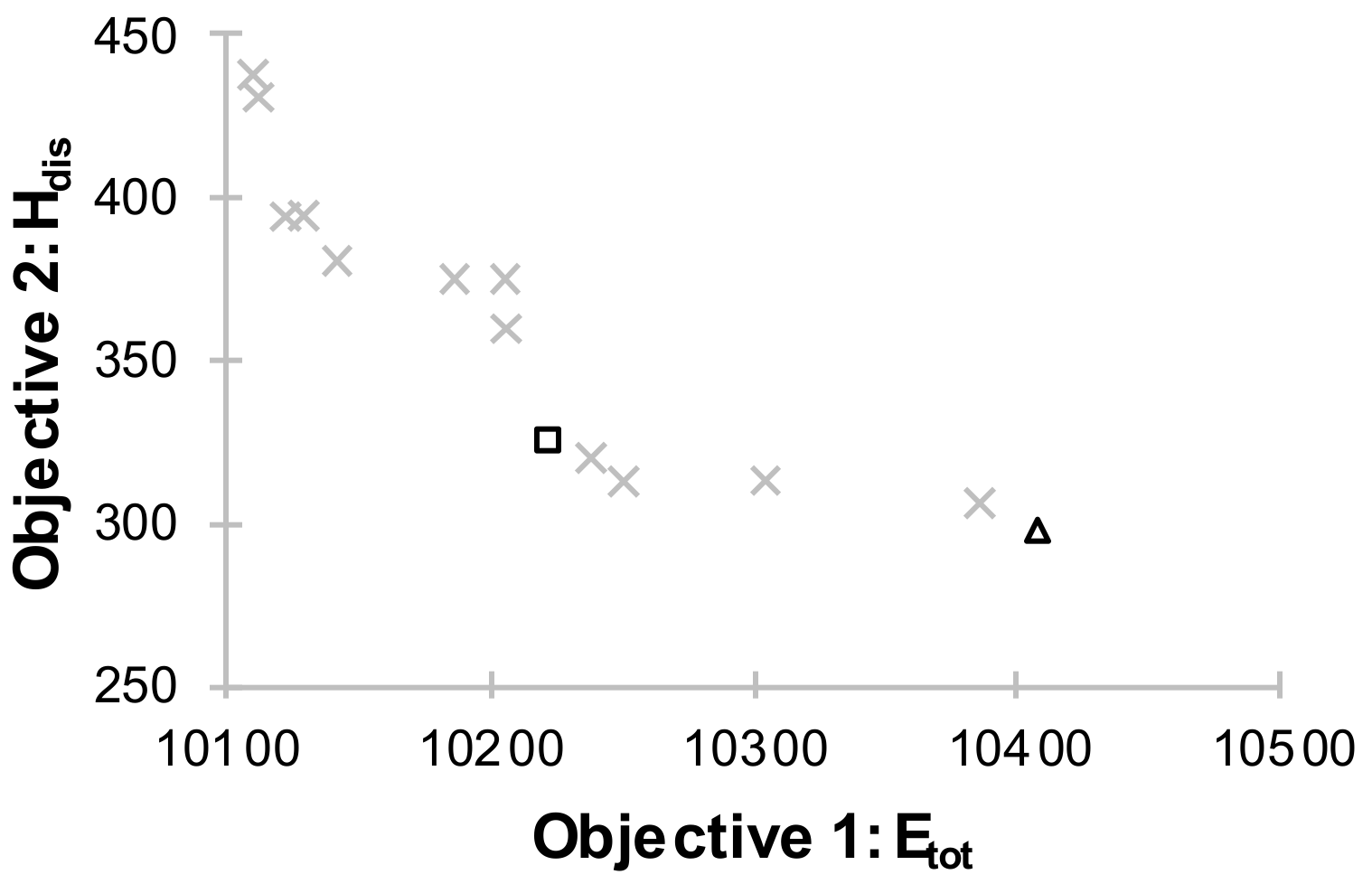

| Case | MCDM | Hdis, % | Etot, kWh | Ecool, kWh | max PMV | max/avg ACH, h−1 |
|---|---|---|---|---|---|---|
| B1 | - | 17.9 | 9478 | - | 3.4 | 0.5/0.38 |
| B2 | - | 8.7 | 10891 | 1462 | 0.8 | 0.3/0.3 |
| 1 | TCC | 1.0 | 9817 | - | 1.9 | 7.2/0.82 |
| 1 | UC | 2.3 | 9514 | - | 2.0 | 7.1/0.70 |
| 2 | TCC | 0.7 | 10514 | 506 | 0.7 | 7.2/0.69 |
| 2 | UC | 0.7 | 10223 | 511 | 0.7 | 7.0/0.66 |
| Type of Room | Hdis, % |
|---|---|
| Living room | 1.92 |
| Room 1 | 0.81 |
| Room 2 | 0.90 |
| Room 3 | 0.96 |
| Room 4 | 0.63 |
© 2018 by the authors. Licensee MDPI, Basel, Switzerland. This article is an open access article distributed under the terms and conditions of the Creative Commons Attribution (CC BY) license (http://creativecommons.org/licenses/by/4.0/).
Share and Cite
Grygierek, K.; Ferdyn-Grygierek, J. Multi-Objectives Optimization of Ventilation Controllers for Passive Cooling in Residential Buildings. Sensors 2018, 18, 1144. https://doi.org/10.3390/s18041144
Grygierek K, Ferdyn-Grygierek J. Multi-Objectives Optimization of Ventilation Controllers for Passive Cooling in Residential Buildings. Sensors. 2018; 18(4):1144. https://doi.org/10.3390/s18041144
Chicago/Turabian StyleGrygierek, Krzysztof, and Joanna Ferdyn-Grygierek. 2018. "Multi-Objectives Optimization of Ventilation Controllers for Passive Cooling in Residential Buildings" Sensors 18, no. 4: 1144. https://doi.org/10.3390/s18041144




